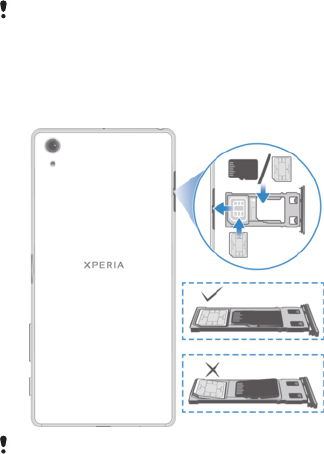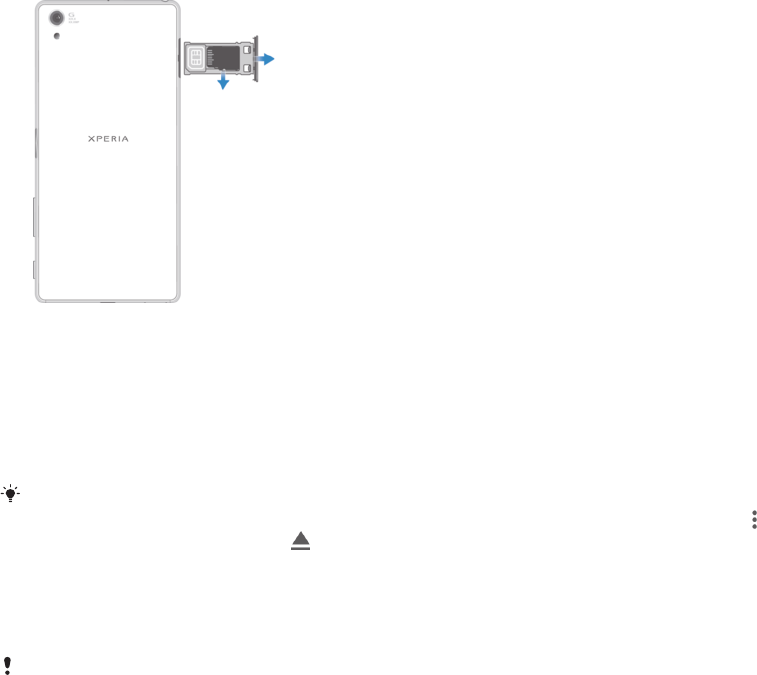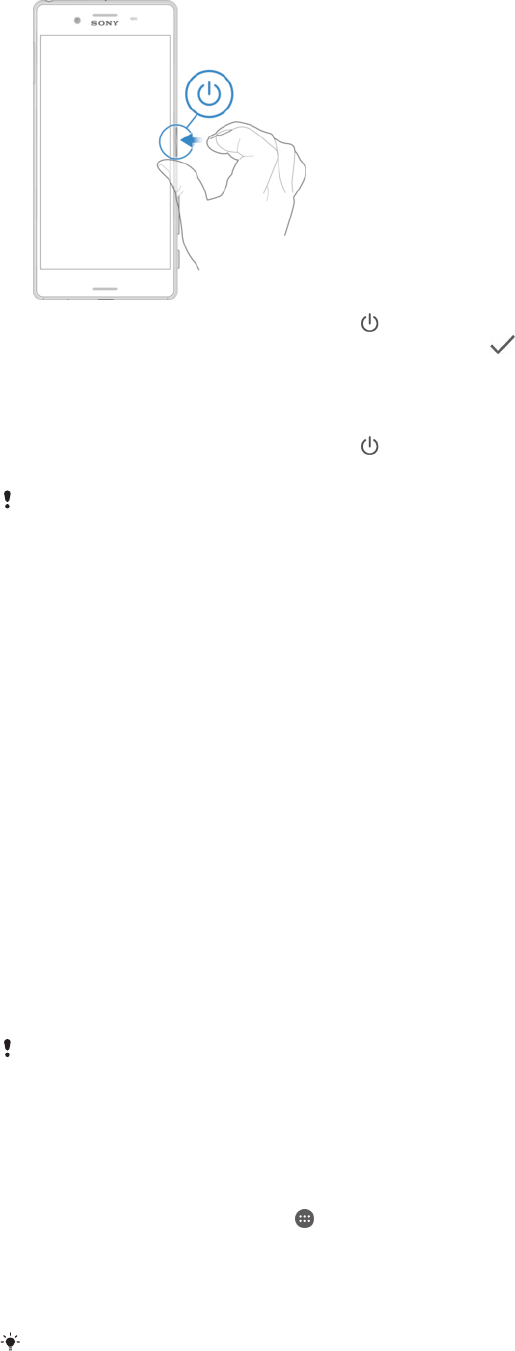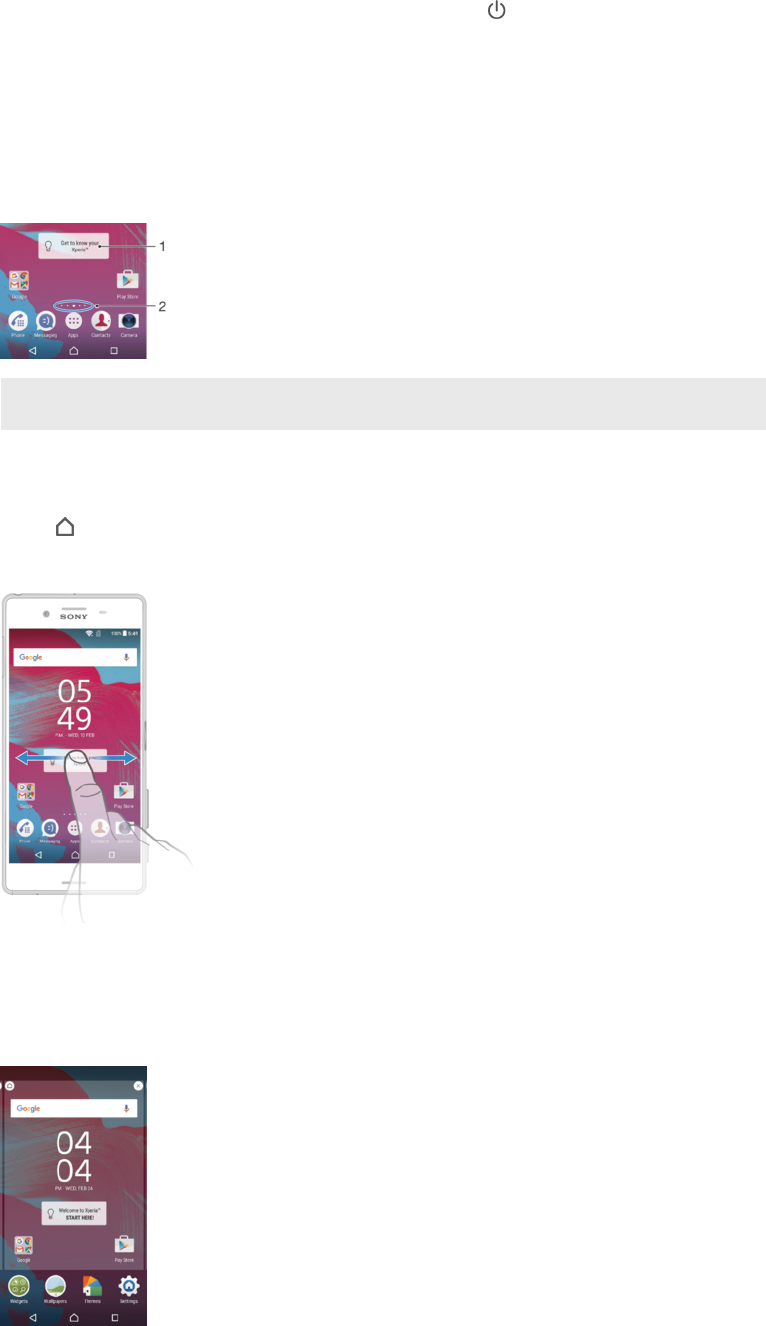Sony PM0930 GSM/WCDMA/LTE Phone + Bluetooth, DTS/UNII a/b/g/n/ac & NFC User Manual Sony Mobile Communications AB
Sony Mobile Communications Inc GSM/WCDMA/LTE Phone + Bluetooth, DTS/UNII a/b/g/n/ac & NFC Sony Mobile Communications AB
Sony >
Contents
- 1. HAC-leaflet
- 2. SAR Leaflet_PY7-PM0930
- 3. Userguide-PY7-PM0930
Userguide-PY7-PM0930

User guide
Xperia™ X
F5121
Contents
Getting started...............................................................................7
About this User guide........................................................................7
Overview............................................................................................7
Assembly...........................................................................................8
Screen protection..............................................................................9
Starting your device for the first time.................................................9
Why do I need a Google™ account?...............................................10
Charging your device.......................................................................11
Device security.............................................................................13
Making sure your device is protected..............................................13
Screen lock......................................................................................13
Fingerprint Manager.........................................................................15
Unlocking your device automatically...............................................16
SIM card protection.........................................................................20
Using multiple SIM cards.................................................................20
Finding the identification number of your device.............................21
Finding a lost device .......................................................................21
Learning the basics......................................................................23
Using the touchscreen.....................................................................23
Locking and unlocking the screen...................................................24
Home screen....................................................................................25
Application screen...........................................................................26
Navigating applications....................................................................27
Widgets............................................................................................28
Shortcuts and folders......................................................................28
Background and themes..................................................................29
Battery and power management.....................................................30
Taking a screenshot.........................................................................31
Notifications.....................................................................................31
Icons in the status bar.....................................................................33
Applications overview......................................................................36
Downloading applications............................................................38
Downloading applications from Google Play™...............................38
Downloading applications from other sources................................38
Internet and networks..................................................................39
Browsing the web............................................................................39
Internet and MMS settings ..............................................................39
Wi-Fi®..............................................................................................40
Sharing your mobile data connection..............................................42
2
This is an Internet version of this publication. © Print only for private use.
Controlling data usage.....................................................................44
Selecting a SIM card for data traffic................................................45
Selecting mobile networks...............................................................45
Virtual private networks (VPNs)........................................................46
Synchronising data on your device..............................................47
Synchronising with online accounts................................................47
Synchronising with Microsoft® Exchange ActiveSync®.................47
Basic settings...............................................................................49
Accessing settings...........................................................................49
Volume settings...............................................................................49
Do not disturb mode settings..........................................................50
Screen settings................................................................................51
Application settings.........................................................................52
Resetting your applications.............................................................53
Daydream.........................................................................................54
Language settings............................................................................54
Date and time...................................................................................54
X-Reality™ for mobile......................................................................55
Super-vivid mode.............................................................................55
Enhancing the sound output............................................................55
Multiple user accounts.....................................................................56
Typing text...................................................................................59
On-screen keyboard........................................................................59
Phonepad.........................................................................................60
Entering text using voice input........................................................61
Editing text.......................................................................................61
Personalising the on-screen keyboard............................................62
Calling..........................................................................................64
Making calls.....................................................................................64
Receiving calls.................................................................................65
Ongoing calls...................................................................................67
Using the call log.............................................................................67
Forwarding calls...............................................................................68
Restricting calls................................................................................68
Multiple calls....................................................................................69
Conference calls..............................................................................70
Voicemail..........................................................................................70
Emergency calls...............................................................................71
Contacts.......................................................................................72
Transferring contacts.......................................................................72
Searching and viewing contacts......................................................73
Adding and editing contacts............................................................74
3
This is an Internet version of this publication. © Print only for private use.
Adding medical and emergency contact information......................75
Favourites and groups.....................................................................76
Sending contact information............................................................77
Avoiding duplicate entries in the Contacts application...................77
Backing up contacts........................................................................77
Messaging and chat.....................................................................79
Reading and sending messages......................................................79
Organising your messages..............................................................80
Calling from a message...................................................................81
Messaging settings..........................................................................81
Instant messaging and video chat...................................................81
Email.............................................................................................82
Setting up email...............................................................................82
Sending and receiving email messages..........................................82
Organising your email messages.....................................................83
Email account settings.....................................................................84
Gmail™............................................................................................84
Music............................................................................................86
Transferring music to your device...................................................86
Listening to music............................................................................86
Music home screen menu................................................................87
Playlists............................................................................................88
Sharing music..................................................................................89
Enhancing the sound.......................................................................89
Recognising music with TrackID™..................................................89
FM radio.......................................................................................91
Listening to the radio.......................................................................91
Favourite radio channels..................................................................92
Sound settings.................................................................................92
Camera.........................................................................................93
Taking photos and recording videos...............................................93
Face detection.................................................................................94
Using Smile Shutter™ to capture smiling faces..............................94
Adding geographical positions to your photos................................94
General camera settings..................................................................95
Still camera settings.........................................................................98
Video camera settings...................................................................101
Photos and videos in Album......................................................104
Viewing photos and videos............................................................104
Sharing and managing photos and videos....................................105
Editing photos with the Photo editor application...........................106
Editing videos with the Video editor application............................107
4
This is an Internet version of this publication. © Print only for private use.
Hiding photos and videos..............................................................107
Album home screen menu.............................................................108
Viewing your photos on a map......................................................109
Videos........................................................................................111
Watching videos in the Video application......................................111
Transferring video content to your device.....................................112
Managing video content................................................................112
Movie Creator................................................................................112
PS Video service............................................................................113
Connectivity...............................................................................114
Mirroring the screen of your device on a TV using a cable............114
Mirroring the screen of your device wirelessly on a TV.................114
Sharing content with DLNA Certified™ devices............................115
Connecting your device to USB accessories................................117
Connecting your device to a DUALSHOCK™ series wireless
controller........................................................................................117
NFC................................................................................................118
Bluetooth® wireless technology....................................................120
Smart apps and features that save you time.............................123
Using your device as a wallet........................................................123
Travel and maps.........................................................................124
Using location services..................................................................124
Google Maps™ and navigation.....................................................124
Using data traffic when travelling..................................................124
Using your device with a car infotainment system........................125
Airplane mode................................................................................125
Calendar and alarm clock..........................................................127
Calendar.........................................................................................127
Alarm and clock.............................................................................127
Accessibility...............................................................................130
Magnification gestures...................................................................130
Large text.......................................................................................130
Colour correction...........................................................................130
TalkBack........................................................................................130
Support and maintenance..........................................................132
Support for your device.................................................................132
Computer tools..............................................................................132
Updating your device.....................................................................133
Memory and storage......................................................................134
Managing files using a computer...................................................135
Backing up and restoring content.................................................135
Running diagnostic tests on your device.......................................138
5
This is an Internet version of this publication. © Print only for private use.
Restarting and resetting your device.............................................138
Warranty, SAR and usage guidelines............................................140
Limitations to services and features..............................................140
Legal information...........................................................................140
6
This is an Internet version of this publication. © Print only for private use.

Getting started
About this User guide
This is the Xperia™ X User guide for the Android™ 6.0 software version. If you're not
sure which software version your device is running, you can check it via the Settings
menu. For more information about software updates, see
Updating your device
on
page 133.
To check the current software version of your device
1From your Home screen, tap .
2Find and tap Settings > About phone > Android™ version.
Overview
7
This is an Internet version of this publication. © Print only for private use.

1. Headset jack
2. NFC™ detection area
3. Front camera lens
4. Ear speaker
5. Charging/Notification light
6. Proximity/Light sensor
7. Power key/Fingerprint sensor
8. Volume/Zoom key
9. Camera key
10. Main loudspeaker
11. Charger/USB cable port
12. Main microphone
13. Wi-Fi/Bluetooth/GPS antenna area
14. Main camera lens
15. Main camera light
16. Second microphone
17. Nano SIM/Memory card slot cover
Assembly
Your device only supports nano SIM cards. The nano SIM card and the memory card
share the same holder but have separate slots in the holder. Make sure you don’t
confuse the two. The combined SIM/Memory card slot allows you to use either a
memory card, or an additional SIM card.
To prevent data loss, make sure you turn off your device or unmount the memory card before
you drag out the holder to remove the nano SIM card (or cards) or memory card from the
device.
To insert one or two nano SIM cards
If you drag out the SIM/Memory card holder while the device is powered on, the device
restarts automatically.
1With the screen facing down, drag out the SIM/Memory card holder using your
finger nail.
2Firmly place a single SIM card in the correct orientation in position one as
shown in the illustration.
3Firmly place the additional SIM card in the correct orientation in position two as
shown in the illustration.
4Make sure all cards are placed horizontally in the holder.
5Insert the holder into the slot, then close the cover.
To insert a memory card
1With the screen facing down, open the nano SIM/Memory card slot cover.
2Place the memory card in the memory card slot in the correct orientation, as
shown in the illustration.
3Close the cover.
To remove the nano SIM card
8
This is an Internet version of this publication. © Print only for private use.

1With the screen facing down, open the cover for the nano SIM card and
memory card slots.
2Using your fingernail or a similar object, drag out the nano SIM card holder.
3Remove the nano SIM card, then re-insert the holder.
4Close the cover.
To remove the memory card
1Turn off the device and with the screen facing down, open the cover for the
nano SIM card and memory card slot.
2Using a fingernail or other similar object, drag out the holder for the nano SIM
card and memory card.
3Remove the memory card from the memory card slot in the holder, then re-
insert the holder.
4Close the cover.
You can also remove the memory card without turning the device off in step 1. To use this
method, you must first unmount the memory card under Settings > Storage & memory > >
Advanced settings > Storage > next to SD card, then follow the rest of the instructions
above.
Screen protection
Before using your device, remove the transparent protection film by pulling up on the
protruding tab.
It is recommended to protect your device with a Sony-branded screen cover or
protector intended for your Xperia™ model. The use of third party screen protection
accessories may prevent your device from working by covering sensors, lenses,
speakers, or microphones and it can invalidate the warranty.
Starting your device for the first time
The first time you start your device, a setup guide opens to help you configure basic
settings, sign in to some accounts and personalise your device. For example, if you
have a Google™ account, you can sign in to it here and get set up straight away.
9
This is an Internet version of this publication. © Print only for private use.

To turn on the device
1Press and hold down the power key until the device vibrates.
2Enter your SIM card PIN when requested, then tap .
3Wait a while for the device to start.
To turn off the device
1Press and hold down the power key until the options menu opens.
2In the options menu, tap Power off.
It may take a while for the device to shut down.
Why do I need a Google™ account?
Your Xperia™ device from Sony runs on the Android™ platform developed by
Google™. A range of Google™ applications and services is available on your device
when you purchase it, for example, Gmail™, Google Maps™, YouTube™ and the
Play Store™ application, which gives you access to the Google Play™ online store
for downloading Android™ applications. To get the most out of these services, you
need a Google™ account. For example, a Google™ account is mandatory if you want
to:
•Download and install applications from Google Play™.
•Synchronise email, contacts and the calendar using Gmail™.
•Chat with friends using the Hangouts™ application.
•Synchronise your browsing history and bookmarks using the Google Chrome™ web
browser.
•Identify yourself as the authorised user after a software repair using Xperia™
Companion.
•Remotely find, lock or clear a lost or stolen device using the my Xperia™ or
Android™ Device Manager services.
For more information about Android™ and Google™, go to
http://support.google.com
.
It is crucial that you remember your Google™ account username and password. In some
situations, you may need to identify yourself for security reasons using your Google™ account.
If you fail to give your Google™ username and password in such situations, your device is
locked. Also, if you have more than one Google™ account, make sure to enter the details for
the relevant account.
To set up a Google™ account on your device
1From your Home screen, tap .
2Find and tap Settings > Accounts & services > Account sync > Add account >
Google.
3Follow the registration wizard to create a Google™ account, or sign in if you
already have an account.
You can also sign in to or create a Google™ account from the setup guide the first time you
start your device. Or you can go online and create an account at
www.google.com/accounts
.
10
This is an Internet version of this publication. © Print only for private use.

To remove a Google™ account
1From your Home screen, tap .
2Tap Settings > Accounts & services > Account sync > Google.
3Select the Google™ account that you want to remove.
4Tap > Remove account.
5Tap Remove account again to confirm.
If you remove your Google™ account, any security features that are linked to your Google™
account will no longer be available.
If you are lending your device to someone to use for an extended period, it is recommended
that you remove your Google™ account from the device.
Charging your device
Your device has an embedded, rechargeable battery that should be replaced only by
Sony or an authorised Sony repair centre. You should never try to open or take apart
the device yourself. Opening the device can cause damage that voids your warranty.
The battery is partly charged when the device is shipped from the factory. Depending
on how long your device was in the box before you purchased it, the battery level
may be quite low. It is therefore recommended that you charge the battery for at least
30 minutes before starting up your device for the first time. You can still use your
device while it is charging. To read more about how to improve the battery
performance, see
Battery and power management
on page 30.
To charge your device
1Plug the charger into a power outlet.
2Plug one end of the USB cable into the charger (or into the USB port of a
computer).
3Plug the other end of the cable into the micro USB port on your device, with
the USB symbol facing up. The notification light illuminates when charging
begins.
4When the device is fully charged, disconnect the cable from your device by
pulling it straight outwards. Make sure not to bend the connector.
If the battery is completely discharged, it may take a few minutes before the notification light
illuminates and the charging icon appears.
11
This is an Internet version of this publication. © Print only for private use.

Battery notification light status
Green The battery is charging and the battery charge level is greater than 90%
Red The battery is charging and the battery charge level is less than 15%
Orange The battery is charging and the battery charge level is less than 90%
12
This is an Internet version of this publication. © Print only for private use.

Device security
Making sure your device is protected
You can prevent other people from using your device without your permission. For
example, if your device is lost, stolen, or wiped, only someone with your Google™
account or screen lock information can use the device. To make sure that your device
is protected, it is important that you set a secure screen lock and add your Google™
account to your device. It is crucial that you remember both your screen lock
information and your Google™ account credentials. To make sure your device is
protected, you can:
•Set a secure screen lock on your device, that is, a PIN, password, or pattern or
fingerprint screen lock to prevent anyone from resetting your device. For more
information, see
Screen lock
on page 13.
•Add a Google™ account to prevent others from using your device if it gets stolen
and/or wiped. For more information, see
Why do I need a Google™ account?
on
page 10.
•Activate either the “Protection by my Xperia” or the Android™ Device Manager web
service. Using one of these services, you can remotely locate, lock or erase a lost
device. For more information, see
Finding a lost device
on page 21 .
Verifying the ownership of your device
Certain protection features require you to either unlock your screen with your PIN,
password, pattern, or enter your Google™ account information. Below are examples
of protection features and some of the required credentials:
Factory Data Reset
protection You must unlock your screen before you are allowed to perform a Factory Data
Reset.
Protection by my
Xperia If you remotely reset your device using this service, you must enter the
username and password for a Google™ account associated with the service.
The device must be connected to the Internet before the setup process can be
completed. Otherwise, you will not be able to use your device after the reset.
Android™ Device
Manager If you remotely reset your device using this service, you must enter the
username and password for a Google™ account. The device must be connected
to the Internet before the setup process can be completed. Otherwise, you will
not be able to use your device after the reset.
Software repair If you use the Xperia™ Companion software to perform a software repair, you’re
asked to enter your Google™ account username and password when you start
the device after the repair is complete.
For Android™ Device Manager, it is necessary to enter information from a Google™ account.
This can be any Google™ account which you have set up on the device. If you cannot provide
the relevant account information during a setup process, you won't be able to use the device
at all.
Screen lock
Fingerprint functionality is not available in the US market.
There are several ways to unlock the screen. The security level of each lock type is
listed below in order of weakest to strongest:
•Swipe – no protection, but you have quick access to the Home screen.
•Pattern – draw a simple pattern with your finger to unlock your device.
•PIN – enter a numeric PIN of at least four digits to unlock your device.
•Password – enter an alpha-numeric password to unlock your device.
13
This is an Internet version of this publication. © Print only for private use.

•Fingerprint – place your registered finger on the power key to unlock your device
It is very important that you remember your screen unlock pattern, PIN or password. If you
forget this information, it may not be possible to restore important data such as contacts and
messages.
If you have set up a Microsoft® Exchange ActiveSync® (EAS) account on your Xperia™
device, the EAS security settings may limit the lock screen type to only a PIN or password.
This occurs when your network administrator specifies a specific lock screen type for all EAS
accounts for enterprise security reasons. Contact the network administrator of your company
or organisation to check what network security policies are implemented for mobile devices.
To create a screen lock pattern
1From your Home screen, tap .
2Find and tap Settings > Lock screen & security > Screen lock > Pattern.
3Follow the instructions on your device.
If you enter an incorrect lock pattern five times in a row, you must wait 30 seconds before
trying again.
To change screen lock type
1From your Home screen, tap .
2Find and tap Settings > Lock screen & security .
To change the screen lock pattern
1From your Home screen, tap .
2Find and tap Settings> Lock screen & security > Screen lock.
3Draw your screen unlock pattern.
4Tap Pattern and follow the instructions on your device.
To create a screen lock PIN
1From your Home screen, tap .
2Find and tap Settings > Lock screen & security > Screen lock > PIN.
3Enter a numeric PIN, then tap Continue.
4Re-enter and confirm your PIN, then tap OK.
To create a screen lock password
1From your Home screen, tap .
2Find and tap Settings > Lock screen & security > Screen lock > Password.
3Enter a password, then tap Continue.
4Re-enter and confirm your password, then tap OK.
To activate the Swipe unlock function
1From your Home screen, tap .
2Find and tap Settings > Lock screen & security > Screen lock.
3Draw your screen unlock pattern, or enter your PIN or password depending on
which of these screen lock types is enabled.
4Tap Swipe.
Fingerprint unlock
Fingerprint functionality is not available in the US market.
You can use your fingerprint to quickly unlock your device. To use this feature, you
need to register a fingerprint and enable this feature in the Fingerprint Manager first.
For details on registering fingerprints, see
Fingerprint Manager
on page 15.
The PIN or password screen lock you set up serves as a backup unlock method if you enable
the Fingerprint unlock option. Selecting other screen lock types will clear all fingerprint
settings.
14
This is an Internet version of this publication. © Print only for private use.

To enable Fingerprint unlock
1From your Home screen, tap .
2Find and tap Settings > Lock screen & security > Fingerprint Manager.
3Confirm your pattern, PIN or password if needed.
4Follow the instructions on your device to set up a fingerprint unlock pattern.
To unlock the device using your fingerprint
•With the lock screen active, place your finger on the power key so that the
device can scan your fingerprint and unlock the screen. Make sure that you
use a finger that you have registered in Fingerprint Manager.
If you fail to unlock the screen using your finger after five attempts, input your backup PIN or
password.
Resetting a forgotten screen lock
If you’ve forgotten your screen lock PIN, password or pattern, you might be able to
reset it using the Protection by my Xperia service. No content on your device is lost
after you have performed a screen lock reset using the Protection by my Xperia
service.
To activate the Protection by my Xperia service, see
Finding a lost device
on page 21.
To reset the screen lock using Protection by my Xperia
1Make sure you know your Google™ account username and password and that
you have enabled the Protection by my Xperia service on your device.
2Go to
myxperia.sonymobile.com
using any Internet-connected device.
3Sign in using the same Google™ account that you have set up on your device.
4Click the picture of your device under Your devices.
5Select Lock or Change PIN2 to replace the current screen lock with a new PIN
code.
6Follow the on-screen instructions provided by Protection by my Xperia.
Depending on your security settings, your device may lock after a screen lock reset. You then
need to enter your Google™ account username and password in order to use the device.
Fingerprint Manager
Fingerprint functionality is not available in the US market.
Fingerprint Manager registers fingerprint information that can be used as an
additional security method for unlocking your device or authenticating purchases.
You are allowed to register a maximum of 5 fingerprints on your device.
Before using the Fingerprint sensor, make sure the sensor is clean and without any visible
moisture.
To register a fingerprint for the first time
1From your Home screen, tap .
2Find and tap Settings > Lock screen & security > Fingerprint Manager.
3Follow the on-screen instructions to complete fingerprint registration.
If you have not set up a PIN or password as a Screen lock, Fingerprint Manager assists you
with setting up a PIN or password as a security backup for your fingerprint. For more
information on setting up a Screen lock, see
Screen lock
on page 13.
The fingerprint sensor is on the power key and not on the screen of your device. Before using
the Fingerprint sensor, make sure the sensor is clean and without any visible moisture.
15
This is an Internet version of this publication. © Print only for private use.

To register additional fingerprints
1From your Home screen, tap .
2Find and tap Settings > Lock screen & security > Fingerprint Manager.
3Tap and then place your finger on the power key so that the device can scan
your fingerprint and verify your identity. Make sure that you use a finger that
you have previously registered in Fingerprint Manager.
4Follow the on-screen instructions to register an additional fingerprint.
To delete a registered fingerprint
1From your Home screen, tap .
2Find and tap Settings > Lock screen & security > Fingerprint Manager.
3Tap the registered fingerprint, then tap Delete > Delete.
To rename a registered fingerprint
1From your Home screen, tap .
2Find and tap Settings > Lock screen & security > Fingerprint Manager.
3Tap a registered fingerprint on the list and then enter a fingerprint name.
4Tap OK.
Unlocking your device automatically
The Smart Lock feature makes unlocking your device easier by letting you set it to
unlock automatically in certain situations. You can keep your device unlocked, for
example, when it’s connected to a Bluetooth® device or when you’re carrying it with
you.
To prepare your device to unlock automatically, you first need to perform the
following steps in the order given:
•Make sure you have an active Internet connection, preferably a Wi-Fi® connection to
limit data traffic charges.
•Make sure that all your apps are updated using the Play Store™ application in order
to ensure that the Google Play™ services app is updated. Having an up-to-date
Google Play™ services app ensures that you can use the latest Smart Lock features.
•Enable Smart Lock.
•Set when you want your device to unlock automatically.
The Smart Lock feature is developed by Google™ and the exact functionality may change over
time due to updates from Google™.
The Smart Lock feature may not be available in every market, country or region.
To enable Smart Lock
1Make sure that you’ve set a pattern, PIN or password for your screen lock.
2From your Home screen, tap .
3Find and tap Settings > Lock screen & security > Trust agents.
4Drag the slider beside Smart Lock (Google) to the right.
5Tap the back arrow next to Trust agents.
6Find and tap Smart Lock.
7Enter your pattern, PIN or password. You need to enter this screen lock any
time you want to change your Smart Lock settings.
8Select a Smart Lock type.
Setting when to keep the device automatically unlocked
You can set Smart Lock to keep your device unlocked using the following settings:
•Trusted devices — Keep your device unlocked when a trusted Bluetooth® device is
connected.
•Trusted places — Keep your device unlocked when you're in a trusted location.
•On-body detection — Keep your device unlocked when you're carrying your device
with you.
16
This is an Internet version of this publication. © Print only for private use.

You have to manually unlock your device when you don't use it for 4 hours and after
you restart it.
Connecting to trusted Bluetooth® devices
You can designate a connected Bluetooth® device as a "trusted" device and keep
your Xperia™ device unlocked while it’s connected to it. So if you have Bluetooth®
devices that you connect to regularly, for example, a car speaker or home
entertainment system, a Bluetooth® watch, or a fitness tracker, you can add them as
trusted devices and bypass the added security of a lockscreen to save time. This
feature is suitable if you’re normally in a relatively secure place when you use these
devices. In some cases, you may still need to manually unlock your device before a
trusted device can be connected.
It is not recommended to add devices that are constantly connected to your device as trusted
devices, for example, Bluetooth® keyboards or cases.
As soon as a trusted Bluetooth® device is switched off or moves out of range, your screen
locks and you need your PIN, pattern or password to unlock it.
To add a trusted Bluetooth® device
1Make sure your device is paired and connected to the Bluetooth® device that
you want to add as a trusted device.
2In the Smart Lock menu, tap Trusted devices.
3Tap Add trusted device > Bluetooth.
4Tap a device name to select it from the list of connected devices. Only paired
devices appear in this list.
5Depending on the security of your connection, you may need to manually
unlock your device before the trusted device can keep it unlocked.
To remove a trusted Bluetooth® device
1From your Home screen, tap .
2Find and tap Settings > Lock screen & security > Smart Lock > Trusted
devices.
3Tap the device that you want to remove.
4Tap Remove trusted device.
Making sure you're secure when using trusted devices
Different Bluetooth® devices support different Bluetooth® standards and security
capabilities. There's a possibility that someone could keep your Xperia™ device
unlocked by imitating your Bluetooth® connection, even if your trusted device is no
longer nearby. Your device is not always able to determine whether your connection
is secure from someone trying to imitate it.
When your device can't determine that you're using a secure connection, you'll get a
notification on your Xperia™ device and may need to manually unlock it before the
trusted device can keep it unlocked.
Bluetooth® connectivity range can vary depending on factors like the model of your
device, the connected Bluetooth® device, and your environment. Depending on
these factors, Bluetooth® connections can work over distances up to 100 meters. If
someone takes your Xperia™ device while it's near a trusted device, they may be
able to access your Xperia™ device if the trusted device has unlocked it.
Connecting to trusted places
When the Trusted places feature is set up, the lock screen security on your Xperia™
device gets disabled when you are in a designated trusted location. For this feature
to work, you must have an Internet connection (preferably over Wi-Fi®) and allow
your device to use your current location.
17
This is an Internet version of this publication. © Print only for private use.

To set up trusted places, first make sure that high accuracy location mode or battery-
saving location mode is enabled on your device before you add home or custom
locations.
The exact dimensions of a trusted location are an estimate and may extend beyond the
physical walls of your home or other area that you have added as a trusted location. This
feature can keep your device unlocked within a radius of up to 80 meters. Also be aware that
location signals can be replicated or manipulated. Someone with access to specialised
equipment could unlock your device.
To add your home location
1Make sure location is turned on and that you are using either the High accuracy
or Battery saving Location mode setting.
2From your Home screen, tap .
3Find and tap Settings > Security > Smart Lock > Trusted places > Home.
4Tap Turn on this location.
To edit your home location
1Make sure location mode is turned on and that you are using either the High
accuracy or Battery saving setting.
2From your Home screen, tap .
3Find and tap Settings > Lock screen & security > Smart Lock > Trusted places.
4Select your home location.
5Tap Edit.
6In the search bar, enter the location that you want to use as your home
location.
If other residences share your street address, you can add the actual location of your home
within the building complex as a custom place.
To remove your home location
1Make sure location mode is turned on and that you are using either the High
accuracy or Battery saving setting.
2From your Home screen, tap .
3Find and tap Settings > Lock screen & security > Smart Lock > Trusted places
> Home.
4Tap Turn off this location.
Using custom locations
You can add any location as a trusted, custom place where your device can remain
unlocked.
To add a custom place
1Make sure location mode is turned on and that you are using either the High
accuracy or Battery saving setting.
2From your Home screen, tap .
3Find and tap Settings > Lock screen & security > Smart Lock > Trusted places.
4Tap Add trusted place.
5To use your current location as a trusted, custom place, tap Select this
location.
6Alternatively, to enter another location, tap the magnification glass icon and
type the address. Your device searches for the entered location. To use the
suggested address, tap the address.
7To fine-tune the location, tap the back arrow next to the address, drag the
location pin to the desired location, then tap Select this location.
18
This is an Internet version of this publication. © Print only for private use.

To edit a custom place
1Make sure location mode is turned on and that you are using either the High
accuracy or Battery saving setting.
2From your Home screen, tap .
3Find and tap Settings > Lock screen & security > Smart Lock > Trusted places.
4Select the place that you want to edit.
5Tap Edit address.
6To enter another location, tap the magnification glass icon and type the
address. Your device searches for the entered location. To use the suggested
address, tap the address.
7To fine-tune the location, tap the back arrow next to the address, then drag the
location pin to the desired location, then tap Select this location.
To remove a custom place
1Make sure location mode is turned on and that you are using either the High
accuracy or Battery saving setting.
2From your Home screen, tap .
3Find and tap Settings > Lock screen & security > Smart Lock > Trusted places.
4Select the place that you want to remove.
5Tap Delete.
Keeping your device unlocked while you’re carrying it
Using the On-body detection feature, you can have your device stay unlocked when
you have it on you, for example, if you're carrying it in your hand, pocket or bag. The
accelerometer in your device keeps your device unlocked when it senses that it's
being carried. The device locks when the accelerometer detects that the device has
been put down.
The On-body detection feature can't distinguish whose body is connected. If you give your
device to someone else while it's unlocked using On-body detection, your device may stay
unlocked for the other user. Keep in mind that On-body detection as a security feature is less
secure than a pattern, PIN, or password.
To enable On-body detection
1From your Home screen, tap .
2Find and tap Settings > Lock screen & security > Smart Lock > On-body
detection.
3Drag the slider beside Off to the right, then tap Continue.
Using On-body detection
When you use the On-body detection feature, you need to be aware of the following
behaviours:
•When your device senses that it's on your body, it stays unlocked after you unlock it.
•Any time you put your device down and it senses that it's no longer on your body,
your device locks automatically.
•After you put your device down, for example, if you place it on a table, your device
can take up to one minute to lock.
•After you get into a car, bus, train or other land vehicles, your device can take
between 5 and 10 minutes to lock.
•Note that when you get on an airplane or a boat (or other non-land based vehicles),
your device may not lock automatically, so make sure to lock it manually if needed.
•When you pick up your device again or get out of the vehicle, just unlock it once and
your device then stays unlocked for as long as you have it on you.
To turn off On-body detection
1From your Home screen, tap .
2Find and tap Settings > Lock screen & security > Smart Lock > On-body
detection.
3Drag the slider beside On to the left.
19
This is an Internet version of this publication. © Print only for private use.

SIM card protection
You can lock and unlock each SIM card that you use in your device with a PIN
(Personal Identity Number). When a SIM card is locked, the subscription linked to the
card is protected against misuse, meaning that you have to enter a PIN every time
you start your device.
If you enter the PIN incorrectly more times than the maximum number of attempts
allowed, your SIM card will become blocked. You then need to enter your PUK
(Personal Unblocking Key) and a new PIN. Your PIN and PUK are supplied by your
network operator.
To set up a SIM card lock
1From the Home screen, tap .
2Find and tap Settings > Lock screen & security > Set up SIM card lock.
3Select a SIM card.
4Drag the slider beside Lock SIM card to the right.
5Enter the SIM card PIN and tap OK. The SIM card lock is now active and you
will be prompted to enter this lock every time you restart the device.
To remove a SIM card lock
1From the Home screen, tap .
2Find and tap Settings > Lock screen & security > Set up SIM card lock.
3Select a SIM card.
4Drag the slider beside Lock SIM card to the left.
5Enter the SIM card PIN and tap OK.
To change the SIM card PIN
1From the Home screen, tap .
2Find and tap Settings > Lock screen & security > Set up SIM card lock.
3Select a SIM card.
4Tap Change SIM PIN.
5Enter the old SIM card PIN and tap OK.
6Enter the new SIM card PIN and tap OK.
7Re-type the new SIM card PIN and tap OK.
To unlock a blocked SIM card using the PUK code
1Enter the PUK code and tap .
2Enter a new PIN code and tap .
3Re-enter the new PIN code and tap .
If you enter an incorrect PUK code too many times, you need to contact your network operator
to get a new SIM card.
Using multiple SIM cards
Your device works with one or two SIM cards inserted. You get incoming
communication to both SIM cards and you can select from which number you want
to place outgoing communication. Before you can use both SIM cards, you need to
enable them and select the SIM card that will handle data traffic.
You can forward calls that come in on SIM card 1 to SIM card 2 when SIM card 1 is
unreachable, and vice versa. This function is called Dual SIM reachability. You must
enable it manually. See
Forwarding calls
on page 68.
To enable or disable the use of two SIM cards
1From the Home screen, tap .
2Find and tap Settings > Dual SIM settings.
3Drag the sliders beside SIM1 and SIM2 to the right or left.
20
This is an Internet version of this publication. © Print only for private use.

To rename a SIM card
1From the Home screen, tap .
2Find and tap Settings > Dual SIM settings.
3Select a SIM card and enter a new name for it.
4Tap OK.
To select the SIM card that handles data traffic
1From your Home screen, tap .
2Find and tap Settings > Dual SIM settings > SIM card for data traffic.
3Select the SIM card that you want to use for data traffic, then tap OK.
For higher data speeds, select the SIM card that supports the fastest mobile network, for
example, 3G.
Finding the identification number of your device
Your device has a unique ID (identification) number. In your device, this number is
referred to as the IMEI (International Mobile Equipment Identity). You should keep a
copy of this number. You may require it, for example, when you access the Xperia™
Care support service and need to register your device. Also, if your device is stolen,
some network providers can use this number to stop the device from accessing the
network in your country.
For devices with two SIM cards, there are two IMEI numbers, one for each SIM card slot.
To view your IMEI numbers on the label tray
1Open the cover for the nano SIM and memory card slot.
2Place a fingernail or other object with a long, fine tip under the edge of the
label tray, then drag the tray outwards. The IMEI numbers are displayed on the
label tray.
To view the IMEI numbers, you can also open the phone dialer and enter *#06#.
To view your IMEI numbers via the device settings
1From your Home screen, tap .
2Find and tap Settings > About phone > Status.
3Select the SIM card, then scroll to IMEI to view the IMEI number.
Finding a lost device
21
This is an Internet version of this publication. © Print only for private use.

If you have a Google™ account, the “Protection by my Xperia” web service can help
you locate and secure your device if you ever lose it. If you have activated this service
on your device, you can:
•Locate your device on a map.
•Sound an alert even if the device is in Do not disturb mode.
•Remotely lock the device and make the device display your contact details to anyone
who finds it.
•Remotely clear the internal and external memory of the device as a last resort.
The “Protection by my Xperia” service may not be available in all countries or regions.
If you’ve cleared the internal memory of the device using the “Protection by my Xperia” web
service, you must sign in to a Google™ account that was previously synced on this device the
next time you turn on the device.
To activate Protection by my Xperia
1Make sure you have an active data connection, and enable location services
on your device.
2From your Home screen, tap .
3Find and tap Settings > Lock screen & security > Protection by my Xperia >
Activate.
4Mark the checkbox to agree to the terms and conditions of the service, then
tap Accept.
5If prompted, sign in to your Google™ account, or create a new account if you
don’t already have one.
To verify that Protection by my Xperia can locate your device, go to
myxperia.sonymobile.com
and sign in using the Google™ account that you are using on your device.
If you are sharing a device with multiple users, note that the Protection by my Xperia service is
only available to the user who is logged in as the owner.
Finding a lost device using Android™ Device Manager
Google™ offers a location and security web service called Android™ Device
Manager. You can use it in parallel with, or as an alternative to, the my Xperia service.
If you lose your device, you can use Android™ Device Manager to:
•Find and show where your device is located.
•Ring or lock your device, erase everything on it, or add a phone number to the lock
screen.
For additional information about Android™ Device Manager, go to
www.support.google.com
.
Android™ Device Manager does not work if your device is turned off or if it does not have a
connection to the Internet. The Android™ Device Manager service may not be available in all
countries or regions.
To activate Android™ Device Manager
1If you are sharing a device with multiple users, make sure that you are logged
in as the owner.
2Make sure that you have an active data connection and that location services
are enabled.
3From your Home screen, tap .
4Find and tap Google Settings > Lock screen & security .
5Drag the sliders beside Remotely locate this device and Allow remote lock and
erase to the right.
6If prompted, agree to the terms and conditions by tapping Activate.
7To verify that Android™ Device Manager can locate your device after you
activate the service, go to
www.android.com/devicemanager
and sign in using
your Google™ account.
22
This is an Internet version of this publication. © Print only for private use.

Learning the basics
Using the touchscreen
Tapping
•Open or select an item.
•Mark or unmark a checkbox or option.
•Enter text using the on-screen keyboard.
Touching and holding
•Move an item.
•Activate an item-specific menu.
•Activate selection mode, for example, to select several items from a list.
Pinching and spreading
•Zoom in or out on web pages, photos and maps, and when you’re taking photos or
shooting videos.
23
This is an Internet version of this publication. © Print only for private use.

Swiping
•Scroll up or down a list.
•Scroll left or right, for example, between Home screen panes.
Flicking
•Scroll quickly, for example, in a list or on a web page. You can stop the scrolling
movement by tapping the screen.
Locking and unlocking the screen
When your device is on and left idle for a set period of time, the screen darkens to
save battery power and locks automatically. This lock prevents unwanted actions on
the touchscreen when you are not using it. When you buy your device, a basic screen
swipe lock is already set. This means that you have to swipe upwards on the screen
to unlock it. You can change the security settings later and add other kinds of locks.
See
Screen lock
on page 13.
To activate the screen
•Briefly press the power key .
24
This is an Internet version of this publication. © Print only for private use.

To lock the screen
•When the screen is active, briefly press the power key .
Home screen
The Home screen is the starting point for using your device. It's similar to the desktop
on a computer screen. Your Home screen can have up to seven panes, which extend
beyond the regular screen display width. The number of Home screen panes is
represented by a series of dots at the lower part of the Home screen. The highlighted
dot shows the pane that you are currently in.
1 Introduction to Xperia™ widget — Tap to open the widget and select a task such as copying
content from your old device or setting up Xperia™ services
2 Dots — Represents the number of Home screen panes
To go to the Home screen
•Press .
To browse the Home screen
Home screen panes
You can add new panes to your Home screen (up to a maximum of seven panes) and
delete panes. You can also set the pane that you want to use as the main Home
screen pane.
25
This is an Internet version of this publication. © Print only for private use.

To set a pane as the main Home screen pane
1Touch and hold an empty area on your Home screen until the device vibrates.
2Flick left or right to browse to the pane that you want to set as your main Home
screen pane, then tap .
To add a pane to your Home screen
1Touch and hold any area on your Home screen until the device vibrates.
2To browse the panes, flick all the way to the right or left, then tap .
To delete a pane from your Home screen
1Touch and hold any area on your Home screen until the device vibrates.
2Flick left or right to browse to the pane that you want to delete, then tap on
the top right corner of the pane.
Home screen settings
To uninstall an application from the Home screen
1Touch and hold any area on your Home screen until the device vibrates.
2Flick left or right to browse the panes. All uninstallable applications are
indicated by .
3Tap the application that you want to uninstall, then tap Delete.
To adjust the size of icons on your Home screen
1Touch and hold any area on your Home screen until the device vibrates, then
tap .
2Tap Icon size, then select an option.
Application screen
The Application screen, which you open from the Home screen, contains the
applications that come pre-installed on your device as well as applications that you
download.
To view all applications on the Application screen
1From your Home screen, tap .
2Flick left or right on the Application screen.
To open an application from the Application screen
•When the Application screen is open, flick left or right to find the application,
and then tap the application.
To search for an application from the Application screen
1When the Application screen is open, tap Search applications.
2Enter the name of the application that you want to search for.
26
This is an Internet version of this publication. © Print only for private use.

To arrange applications on the Application screen
1When the Application screen is open, tap .
2Tap Sort apps, then select an option.
To add an application shortcut to the Home screen
1On the Application screen, touch and hold an application icon until it becomes
selected, then drag the icon to the top of the screen. The Home screen opens.
2Drag the icon to the desired location on the Home screen, then release your
finger.
To move an application on the Application screen
1When the Application screen is open, tap .
2Make sure that Own order is selected under Sort apps.
3Touch and hold the application until it becomes selected, then drag it to the
new location.
To uninstall an application from the Application screen
1Touch and hold any area on the Application screen until the device vibrates. All
applications that can be uninstalled are then indicated by .
2Select the application that you want to uninstall, then tap Delete.
Navigating applications
You can navigate between applications using the navigation keys, the favourites bar,
and the recently used applications window, which lets you switch easily between all
recently used applications. The navigation keys are the Home key, the Recent apps
key and the Back key. Some applications get closed when you press the Home key
to exit while others are paused or continue to run in the background. If an
application is paused or running in the background, you can continue where you left
off the next time you open the application.
1 Recently used applications window – Open a recently used application
2 Recent apps key – Open the recently used applications window and the favourites bar
3 Home key – Exit an application and go back to the Home screen
4 Back key – Go back to the previous screen within an application or close the application
To open the recently used applications window
•Press .
To close all the recently used applications
•Tap and then tap .
27
This is an Internet version of this publication. © Print only for private use.

To open a menu in an application
•While using the application, press .
A menu is not available in all applications.
Widgets
Widgets are small applications that you can use directly on your Home screen. They
also function as shortcuts. For example, the Weather widget allows you to see basic
weather information directly on your Home screen. But when you tap the widget, the
full Weather application opens. You can download additional widgets from Google
Play™.
To add a widget to the Home screen
1Touch and hold an empty area on your Home screen until the device vibrates,
then tap Widgets.
2Find and tap the widget that you want to add.
To resize a widget
1Touch and hold a widget until it magnifies and the device vibrates, then release
the widget. If the widget can be resized, for example, the Calendar widget,
then a highlighted frame and resizing dots appear.
2Drag the dots inward or outward to shrink or expand the widget.
3To confirm the new size of the widget, tap anywhere on the Home screen.
To move a widget
•Touch and hold the widget until it magnifies and the device vibrates, then drag
it to the new location.
To remove a widget
•Touch and hold the widget until it becomes selected, then drag it to Remove
from Home screen.
Shortcuts and folders
Use shortcuts and folders to manage your applications and keep your Home screen
tidy.
28
This is an Internet version of this publication. © Print only for private use.

1 Access an application using a shortcut
2 Access a folder containing applications
To add an application shortcut to your Home screen
1Touch and hold an empty area on your Home screen until the device vibrates
and the customisation menu appears.
2In the customisation menu, tap Apps.
3Scroll through the list of applications and select an application. The selected
application gets added to the Home screen.
In step 3, alternatively, you can tap Shortcuts and then select an application from the list
available. If you use this method to add shortcuts, some of the applications available allow
you to add specific functionality to the shortcut.
To move an item on the Home screen
•Touch and hold the item until it becomes selected, then drag the item to the
new location.
To remove an item from the Home screen
•Touch and hold the item until it becomes selected, then drag the item to
Remove from Home screen on the top of the screen.
To create a folder on the Home screen
•Touch and hold an application icon or a shortcut until it becomes selected,
then drag and drop it on top of another application icon or shortcut.
To add items to a folder on the Home screen
•Touch and hold an item until it becomes selected, then drag the item to the
folder.
To rename a folder on the Home screen
1Tap the folder to open it.
2Tap the folder's title bar to show the Folder name field.
3Enter the new folder name and tap Done.
Background and themes
You can adapt the Home screen to your own style using wallpapers and different
themes.
To change your Home screen wallpaper
1Touch and hold an empty area on your Home screen until the device vibrates.
2Tap Wallpapers and select an option.
29
This is an Internet version of this publication. © Print only for private use.

To set a theme
1Touch and hold an empty area on your Home screen until the device vibrates.
2Tap Themes.
3Select an option and follow the instructions in your device.
When you change a theme, the background also changes in some applications.
Battery and power management
Your device has an embedded battery. You can keep track of your battery
consumption and see how much power applications are using. You can remove apps
and activate a number of power saving modes to get more out of your battery. You
can also view an estimate of how much battery time is left and adjust your settings to
improve performance and make your battery last longer.
To view your battery consumption and estimated battery time
1From your Home screen, tap .
2Find and tap Settings > Battery. An overview appears showing battery
percentage and an estimated battery time.
3You can configure and activate power saving modes from this page.
4Tap SHOW BATTERY USAGE to view a list of features and services that have
consumed battery power since the last charging cycle. Tap any of them to see
details of its energy consumption.
To view how much battery power applications use
1From your Home screen, tap .
2Find and tap Settings > Apps.
3Select an application and review its battery consumption via App info > Battery
usage.
Battery optimisation
Battery optimisation is a powerful and convenient built-in mode which improves your
battery life significantly by reducing battery consumption when you are not using the
device or certain apps.
This is achieved by suspending battery draining network activities, such as location
services, syncing and Wi-Fi® scanning in the background when you have not been
using your device for a long time.
Phone calls and SMS messaging are not affected.
To make specific applications exempt from optimisation
You can make applications exempt from being optimised.
1From your Home screen, tap .
2Find and tap Settings > Battery.
3Tap the and select Battery optimisation. You will see a list of applications that
are not optimised.
4To add or remove applications from this list, tap Apps and select or de-select
an application from the list to edit its optimisation settings.
5The list of applications that are not optimised will get updated according to
your settings.
You can also configure Battery optimisation from the Apps menu by tapping .
Power saving modes
There are several power saving modes available for you to use if you want to make
your battery last longer:
30
This is an Internet version of this publication. © Print only for private use.

STAMINA mode Disables Wi-Fi® and mobile data when the screen is turned off, and restricts hardware
performance. appears in the status bar when this mode takes effect.
Ultra STAMINA
mode
Limits your device’s functionality to core tasks such as making phone calls and
sending SMS messages. appears in the status bar once this mode is activated.
If you are using a device with multiple users, you may need to log in as the owner, that is, the
primary user, to activate or deactivate a power saving mode.
To activate STAMINA mode
1From your Home screen, tap .
2Find and tap Settings > Battery.
3Tap STAMINA mode and select the preferred option.
appears in the status bar when STAMINA mode is active.
You can adjust the Auto start percentage according to your preferences.
To activate Ultra STAMINA mode
1From your Home screen, tap .
2Find and tap Settings > Battery.
3Tap Ultra STAMINA mode and then tap Activate .
4Confirm to activate.
Your Home screen is replaced by STAMINA Home and appears in the status bar
when Ultra STAMINA mode is active.
Taking a screenshot
You can capture still images of any screen on your device as a screenshot.
Screenshots you take are automatically saved in Album.
To take a screenshot
1Press and hold down the power key until a prompt window appears.
2Tap .
You can also take a screenshot by pressing and holding the power key and volume down key
at the same time. Once the screenshot is captured, you can release the keys.
To view your screenshot
•Drag the status bar fully downwards, then tap the screenshot you want to view.
You can also view your screenshots by opening the Album application.
Notifications
Notifications inform you of events such as new messages and calendar notifications
as well as activities in progress such as file downloads. Notifications appear in the
following places:
•The status bar
•The Notification panel
•The lock screen
31
This is an Internet version of this publication. © Print only for private use.

To open or close the Notification panel
1To open the Notification panel, drag the status bar downwards.
2To close the Notification panel, drag the panel upwards.
To take action on a notification in the Notification panel
•Tap the notification.
To dismiss a notification from the Notification panel
•Place your finger on a notification and flick left or right.
To expand a notification on the Notification panel
•Drag the notification downwards.
Not all notifications are expandable.
To clear all notifications from the Notification panel
•Tap .
To take action on a notification from the lock screen
•Double-tap the notification.
To dismiss a notification from the lock screen
•Place your finger on the notification and flick left or right.
To expand a notification on the lock screen
•Drag the notification downwards.
Not all notifications are expandable.
Managing notifications on the lock screen
You can set up your device so that only selected notifications get displayed on your
lock screen. You can make all notifications and their content accessible, hide
sensitive content for all notifications or specific apps, or choose not to show any
notifications at all.
To select the notifications to display on the lock screen
1From your Home screen, tap .
2Find and tap Settings > Sound & notification > When device is locked.
3Select an option.
32
This is an Internet version of this publication. © Print only for private use.

Notification display options on the lock screen
Show all notification
content
Get all notifications on the lock screen. When you have this setting turned on, keep
in mind that all content (including the content of incoming emails and chats) will be
visible on your lock screen unless you designate the relevant apps as Hide
sensitive content in the App notifications settings menu.
Hide sensitive
notification content
You must have a PIN, password, or pattern set up as your screen lock in order for
this setting to be available. Contents hidden is displayed on the lock screen when
sensitive notifications arrive. For example, you'll get a notification for an incoming
email or chat, but the content won't be visible on your lock screen.
Don't show
notifications at all
You won't get any notifications on the lock screen.
Setting the notification level for an app
You can set different notification behaviour for individual applications. For example,
you can block all email notifications, prioritise Facebook™ notifications and make the
content of messaging notifications invisible on the lock screen.
To set the notification level for an app
1From your Home screen, tap .
2Find and tap Settings > Sound & notification > App notifications.
3Select the app for which you want to change the notification settings.
4Drag the relevant slider to the right.
Notification levels and options for specific applications
Block all Never show notifications for the selected app.
Treat as priority Receive the selected app’s notifications when Do not disturb is set to Priority only.
Allow peeking Let the selected app emphasise certain notifications by sliding them briefly into view on
the current screen.
Notification light
The notification light informs you about battery status and some other events. For
example, a flashing white light means there is a new message or a missed call. The
notification light is enabled by default but can be disabled manually.
When the notification light is disabled, it only lights up when there is a battery status warning,
for example, when the battery level goes below 15 percent.
To enable the notification light
1From your Home screen, tap .
2Find and tap Settings > Sound & notification .
3Drag the slider beside Notification light to the right.
Icons in the status bar
Status icon
No SIM card
Signal strength
No signal
33
This is an Internet version of this publication. © Print only for private use.

Roaming
Sending and downloading LTE data
Sending and downloading GPRS data
Sending and downloading EDGE data
Sending and downloading 3G data
Sending and downloading mobile data
A Wi-Fi® connection is enabled and data is being transmitted
A Wi-Fi® connection is enabled but there is no Internet connection.
This icon also appears when you are trying to connect to a secured Wi-Fi®
network. After a successful login, the exclamation mark disappears.
In places where Google™ is blocked, for example, China, the exclamation
mark may appear even when the device is connected to a Wi-Fi® network
and there is a working Internet connection
Battery status
The battery is charging
STAMINA mode is activated
Airplane mode is activated
The Bluetooth® function is activated
SIM card 1 is inserted
SIM card 2 is inserted
The microphone is muted
The speakerphone is on
Do not disturb mode is activated
Allow exceptions in Do not disturb mode
Vibrate mode
An alarm is set
GPS is activated
Synchronisation is ongoing
Problem with sign-in or synchronisation
The Hearing aid function is activated
Depending on your service provider, network and/or region, the functions or services
represented by some icons in this list may not be available.
To manage status bar icons
1From your Home screen, tap .
2Find and tap Settings > Display> System icons.
3Mark the checkboxes for the system icons that you want to appear in the
status bar.
34
This is an Internet version of this publication. © Print only for private use.

Notification icons
New text message or multimedia message
Missed call
Call on hold
Call forwarding is turned on
New voicemail message
New email message
Downloading data
Uploading data
Mobile data is disabled
Perform a basic setup of your device
A software update is available
System updates are available
Downloading system updates
Tap to install the downloaded system updates
Ultra STAMINA mode is activated
Noise cancelling is on
Screenshot captured
New Hangouts™ chat message
Video chat with friends using the Hangouts™ application
Upcoming calendar event
A song is playing
The radio is on
The device is connected to a computer via a USB cable
Internal storage is 75% full. Tap to transfer data to a memory card
Warning
More (undisplayed) notifications
Not all icons that may appear on your device are listed here. These icons are for reference
purposes only, and changes may be made without notice.
To block an application from sending notifications
1From your Home screen, tap .
2Find and tap Settings > Sound & notification> App notifications.
3Select an application.
4Drag the slider beside Block all to the right.
35
This is an Internet version of this publication. © Print only for private use.

Applications overview
Use the Alarm & clock application to set various kinds of alarms.
Use your web browser to navigate and view web pages, manage bookmarks,
text and images.
Use the Calculator application to perform basic calculations.
Use the Calendar application to keep track of events and manage your
appointments.
Use the camera to take photos and record video clips.
Use the Contacts application to manage phone numbers, email addresses
and other information related to your contacts.
Access your downloaded applications, documents and pictures.
Use the Email application to send and receive emails through both private
and corporate accounts.
Use the Facebook™ application to engage in social networking with friends,
family members and colleagues around the world.
Browse and listen to FM radio stations.
Use the Album application to view and to work with your photos and videos.
Use the Gmail™ application to read, write and organise email messages.
Search for information on your device and on the web.
View your current location, find other locations and plan routes using Google
Maps™.
Use the Play Store™ application to download free and paid applications for
your device.
Use the Messaging application to send and receive text and multimedia
messages.
Use the Video application to play videos on your device and share content
with your friends.
Use the Music application to organise and play music and audio books.
View news stories from Xperia™ News.
Use the Weather application to view weather forecasts.
Make phone calls by dialling the number manually or by using the smart dial
function.
Optimise settings to suit your own requirements.
Use the Hangouts™ application to chat with friends online.
Identify music tracks that you hear playing in your surroundings, and get
artist, album and other info.
Use YouTube™ to share and view videos from around the world.
The Xperia™ Movie Creator automatically creates short videos of around 30
seconds in length using existing photos and videos.
Use the Lifelog application to automatically log events about your daily life.
For example, you can set goals and track your progress in achieving them or
bookmark special moments.
36
This is an Internet version of this publication. © Print only for private use.

Use the Support application to access user support on your device. For
example, you can access a User guide, troubleshooting information, plus tips
and tricks.
Some applications are not supported or listed by all networks and/or service providers in all
areas.
37
This is an Internet version of this publication. © Print only for private use.

Support and maintenance
Support for your device
Use the Support application in your device to search a User guide, read
troubleshooting guides, and find information about software updates and other
product-related information.
To access the Support application
1From your Home screen, tap .
2Find and tap , then select the required support item.
For best support available, we recommend connecting to the Internet when using the Support
application.
Help in menus and applications
Some applications and settings have help available in the options menu, which is
normally indicated by in the specific applications.
Help us improve our software
You can enable the sending of usage info from your device so that Sony Mobile can
receive anonymous bug reports and statistics that help improve our software. None
of the information gathered includes personal data.
To allow the sending of usage info
1From your Home screen, tap .
2Find and tap Settings > About phone > Usage info settings.
3Mark the Send usage info checkbox if it is not already marked.
4Tap Agree.
Computer tools
There are a number of tools available to help you connect your device to a computer
and manage content such as contacts, movies, music and photos.
This device has a capless USB port. If your device gets exposed to water, ensure the USB port
is completely dry before inserting a USB cable.
Xperia™ Companion
Xperia™ Companion is a computer software with a collection of tools and
applications you can use when you connect your device to a computer. With Xperia™
Companion, you can:
•Update or repair your device’s software.
•Transfer content from your device using Xperia™ Transfer.
•Back up and restore content on your computer.
•Sync multimedia content – camera content, music and playlists between your device
and computer.
•Browse files on your device.
To use Xperia™ Companion, you need an Internet-connected computer running one
of the following operating systems:
•Microsoft® Windows® 7 or later
•Mac OS® X 10.8 or later
You can download Xperia™ Companion at http://support.sonymobile.com/global-en/
tools/xperia-companion.
132
This is an Internet version of this publication. © Print only for private use.

Media Go™ for Microsoft®Windows®
The Media Go™ application for Windows® computers helps you transfer photos,
videos and music between your device and a computer. To read more about how to
use the Media Go™ application, go to http://mediago.sony.com/enu/features.
To use the Media Go™ application, you need one of these operating systems:
•Microsoft® Windows® 10
•Microsoft® Windows® 8 / 8.1
•Microsoft® Windows® 7
•Microsoft® Windows Vista®
Updating your device
You should update the software on your device to get the latest functionality,
enhancements and bug fixes in order to ensure optimal performance. When a
software update is available, appears in the status bar. You can also check for new
updates manually.
The easiest way to install a software update is to do it wirelessly from your device.
However, some updates are not available for wireless download. You then need to
use the Xperia™ Companion software on a PC or on an Apple® Mac® computer to
update your device.
For more information about software updates, go to
www.sonymobile.com/update
.
If you are using a device with multiple users, you must log in as the owner, that is, the primary
user, to update the device.
Insufficient remaining storage capacity may prevent updates. Ensure you have sufficient
storage capacity before attempting to update.
To check for new software
1If you are using a device with multiple users, make sure you are logged in as
the owner.
2From your Home screen, tap .
3Find and tap Settings > About phone > Software update.
If no new software is available, it’s possible that you may not have enough free memory on
your device. If your Xperia™ device has less than 500 MB of free internal memory (device
memory) available, you do not receive any information about new software. The following
notification appears in the Notification panel to warn of the lack of storage space: Storage
space running out. Some system functions may not work. If you receive this notification, you
must free up internal memory (device memory) before you can get notifications about new
software being available.
To download and install a system update
1If you are using a device with multiple users, make sure you are logged in as
the owner.
2From your Home screen, tap .
3Find and tap Settings > About phone > Software update.
4If a system update is available, tap Download to download it to your device.
5When the download is finished, tap Install and follow the on-screen instructions
to complete the installation.
133
This is an Internet version of this publication. © Print only for private use.

To download and install a system update from the Notification panel
1If you are using a device with multiple users, make sure you are logged in as
the owner.
2Drag the status bar downwards to open the Notification panel.
3Scroll down and select the desired system update, then tap Download.
4When the download is finished, open the Notification panel again if it is closed,
then tap Install and follow the on-screen instructions to complete the
installation.
Memory and storage
Your device has different types of memory and storage options.
•The eMMC (embedded Multi-Media Controller) memory, which consists of the
system memory and the internal storage, is about 32 GB. The system memory is
used for the Android™ operating system and for most pre-installed applications. The
internal storage is used to store downloaded or transferred content along with
personal settings and data. Some examples of data stored to the internal storage are
alarm, volume and language settings; emails; bookmarks; calendar events; photos;
videos and music.
•You can use a removable memory card with a storage capacity of up to 200 GB to
get more storage space. Media files and some apps (with their data) can be moved to
this type of memory to free up internal storage. Some apps, for example, the Camera
app, can save data directly to a memory card.
•The dynamic memory (RAM) is about 3 GB and cannot be used for storage. RAM is
used to handle running applications and the operating system.
You may have to purchase a memory card separately.
Read more about the use of memory in Android™ devices by downloading the White paper
for your device at
www.sonymobile.com/support
.
Improving memory performance
The memory in your device tends to fill up as a result of normal usage. If the device
starts to slow down, or applications suddenly shut down, you should consider the
following:
•Always have more than 500 MB of free internal storage available.
•Close down running applications that you are not using.
•Clear the cache memory for all applications.
•Uninstall downloaded applications that you don't use.
•Move applications to the memory card if the internal storage is full.
•Transfer photos, videos and music from the internal memory to the memory card.
•If your device can't read content on the memory card, you may need to format the
card. Note that all content on the card gets erased when you format it.
If you are using a device with multiple users, you must log in as the owner, that is, the primary
user, to be able to perform certain actions, such as transferring data to the memory card and
formatting the memory card.
To view the memory status
1From your Home screen, tap .
2Find and tap Settings > Storage & memory.
To view the amount of free and used RAM
1From your Home screen, tap .
2Find and tap Settings > Apps.
134
This is an Internet version of this publication. © Print only for private use.

To clear the cache memory for all applications
1From your Home screen, tap .
2Find and tap Settings > Storage & memory.
3Tap , then tap Advanced settings > Storage, then find and tap Cached data >
OK.
When you clear the cache memory, you don't lose any important information or settings.
To transfer media files to the memory card
1Make sure you have a memory card inserted into your device.
2From your Home screen, tap .
3Find and tap Settings > Storage & memory > Transfer data.
4Mark the file types that you want to transfer to the memory card.
5Tap Transfer.
To stop applications and services from running
1From your Home screen, tap .
2Find and tap Settings > Apps.
3Select an application or service, then tap FORCE STOP > OK.
To format the memory card
1From your Home screen, tap .
2Find and tap Settings > Storage & memory.
3Tap , then tap Advanced settings > Storage > SD Card > , then tap Settings >
Format > Erase & format.
All content on the memory card gets erased when you format it. Make sure you make a
backup of all data that you want to save before formatting a memory card. To back up your
content, you can copy it to a computer. For more information, see
Backing up data with the
Xperia™ Backup & restore application
on page 136.
Managing files using a computer
Use a USB cable connection between a Windows® computer and your device to
transfer and manage your files. Once the two devices are connected, you can drag
and drop content between your device and the computer, or between your device's
internal storage and SD card, using the computer's file explorer.
If you have a PC or an Apple® Mac® computer, you can use Xperia™ Companion to
access the file system of your device.
Backing up and restoring content
Generally, you should not save photos, videos and other personal content solely on
the internal memory of your device. If something should happen with the hardware, or
if your device is lost or stolen, the data stored on its internal memory is gone forever.
It is recommended to use the Xperia™ Companion software to make backups which
save your data safely to a computer, that is, an external device. This method is
especially recommended if you are updating your device software to a newer Android
version.
Using the Backup & Restore application, you can make a quick online backup of
basic settings and data with your Google™ account. You can also use this
application to back up data locally, for example, to the SD card in your device or to
an external USB storage device.
It is very important that you remember the password that you set when you make a data
backup. If you forget the password, it may not be possible to restore important data such as
contacts and messages.
135
This is an Internet version of this publication. © Print only for private use.

Backing up data to a computer
Use the Xperia™ Companion software to back up data from your device to a PC or
an Apple® Mac® computer. These backup applications let you back up the following
types of data:
•Contacts and call logs
•Messages
•Calendar
•Settings
•Media files such as music and videos
•Photos and images
To back up your data using a computer
1Make sure that the Xperia™ Companion software is installed on the PC or
Apple® Mac® computer.
2Connect your device to the computer using a USB cable.
3Computer: Open the Xperia™ Companion software. After a few moments, the
computer detects your device.
4Select Backup on the main screen.
5Follow the on-screen instructions to back up data from your device.
To restore your data using a computer
1Make sure that the Xperia™ Companion software is installed on the PC or on
the Apple® Mac® computer.
2Connect your device to the computer using a USB cable.
3Computer: Open the Xperia™ Companion software.
4Click Restore .
5Select a backup file from the backup records, then tap Restore and follow the
on-screen instructions to restore data to your device.
Backing up data with the Xperia™ Backup & restore application
Using the Xperia™ Backup & restore application, you can make an online backup or
a local backup of data. For example, you can back up data manually or turn on the
automatic backup function to save data periodically.
The Xperia™ Backup & restore application is recommended for backing up data
before you do a factory data reset. With this application you can back up the
following types of data to an online account, an SD card or to an external USB
storage device that you have connected to your device using a USB Host adapter:
•Bookmarks
•Contacts and call log
•Conversations
•Calendar data
•Email accounts
•Wi-Fi® networks
•Device settings
•Applications
•Xperia™ Home layout
To back up content to an online account
1From your Home screen, tap .
2Find and tap Settings > Backup & reset.
3To enable the automatic backup function, tap Automatic backup and then tap
the on-off switch.
4To enable the manual backup function, tap More > Manual backup.
5Under Where to store files, tap Select storage > Online account.
6If prompted, read the relevant terms and provided you agree, tap I agree, then
follow the on-screen instructions to sign in to your Google™ account.
7Select the types of data to back up, then tap Back up.
136
This is an Internet version of this publication. © Print only for private use.

To set up the automatic backup function
1If you are backing up content to a USB storage device, make sure the storage
device is connected to your device using a USB Host adapter. If you are
backing up to an SD card, make sure that the SD card is properly inserted into
your device. If you are backing up content to an online account, make sure you
have signed in to your Google ™ account.
2From your Home screen, tap .
3Find and tap Settings > Backup & reset.
4Under Xperia™ Backup & Restore, tap Automatic backup.
5To enable the automatic backup function, tap the on-off switch.
6Select a backup frequency, where to save backup files, the time to back up
and the types of data to back up.
7To save your settings, tap .
To back up content manually
1If you are backing up content to a USB storage device, make sure the storage
device is connected to your device using a USB Host adapter. If you are
backing up to an SD card, make sure the SD card is properly inserted in your
device. If you are backing up content to an online account, make sure you
have signed in to your Google ™ account.
2From your Home screen, tap .
3Find and tap Settings > Backup & reset.
4Under Xperia™ Backup & Restore, tap More.
5Tap Manual backup, then select a backup destination and the data types that
you want to back up.
6Tap Back up.
7After the data is backed up, tap Finish.
To edit a backup file
1From your Home screen, tap .
2Find and tap Settings > Backup & reset.
3Under Xperia™ Backup & Restore, tap More.
4Tap Edit backup file, then select a backup source and the data types that you
want to delete.
5Tap Delete data.
6Tap OK to confirm.
7After the data is deleted, tap Finish.
To restore backed up content
1If you are restoring content from a USB storage device, make sure the storage
device is connected to your device using the USB Host adapter. If you are
restoring content from an SD card, make sure the SD card is properly inserted
in your device. If you are restoring content from an online account, make sure
you have signed in to your Google™ account.
2From your Home screen, tap .
3Find and tap Settings > Backup & reset.
4Under Xperia™ Backup & Restore, tap Restore data, then select a restore
source and the data types that you want to restore.
5Tap Restore data.
6After the content is restored, tap Finish.
Remember that any changes that you make to your data and settings after you create a
backup, including any applications you download, get deleted during a restore procedure.
Backing up data with the Google Backup & restore application
Using the Google Backup & restore application, you can back up data to a Google
server. You can also turn on the automatic restore function to restore application data
and settings when you reinstall an application.
With this application you can back up the following types of data:
137
This is an Internet version of this publication. © Print only for private use.

•Applications
•Bookmarks
•Wi-Fi® networks
•Other settings
To back up data to an online account
1From your Home screen, tap .
2Find and tap Settings > Backup & reset.
3Under Google™ Backup & Restore, tap Back up my data and drag the slider to
the right.
To enable automatic restore when you reinstall an application
1From your Home screen, tap .
2Find and tap Settings > Backup & reset.
3Under Google™ Backup & Restore, drag the slider beside Automatic restore to
the right.
Running diagnostic tests on your device
The Xperia™ Diagnostics application can test a specific function or run a full
diagnostic test to check if your Xperia™ device is working properly.
Xperia™ Diagnostics can:
•Assess potential hardware or software issues on your Xperia™ device.
•Analyse how well applications perform on your device.
•Log the number of dropped calls during the previous 10 days.
•Identify installed software and provide useful details about your device.
The Xperia™ Diagnostics application is pre-installed on most Android™ devices from Sony. If
the Diagnostics option is not available under Settings > About phone, you can download a
light version using the Play Store™ application.
To run a specific diagnostic test
1From your Home screen , tap .
2Find and tap Settings > About phone > Diagnostics > Test .
3Select a test from the list.
4Follow the instructions and tap Yes or No to confirm if a feature works.
To run all diagnostic tests
1From your Home screen , tap .
2Find and tap Settings > About phone > Diagnostics > Test > Run all.
3Follow the instructions and tap Yes or No to confirm if a feature works.
To view details about your device
1From your Home screen , tap .
2Find and tap Settings > About phone > Diagnostics > Facts.
Restarting and resetting your device
You can force your device to restart or shut down in situations where it stops
responding or won't restart normally. No settings or personal data get deleted.
You can also reset your device to its original factory settings. This action is
sometimes necessary if your device stops functioning properly, but note that if you
want to keep any important data, you have to first back up this data to a memory
card or other non-internal memory. For more information, see
Backing up and
restoring content
on page 135.
138
This is an Internet version of this publication. © Print only for private use.

If your device fails to power on or you want to reset your device’s software, you can
use Xperia™ Companion to repair your device. For more information on using
Xperia™ Companion, see
Computer tools
on page 132.
Your device may fail to restart if the battery level is low. Connect your device to a charger and
try restarting again.
If you are sharing a device with multiple users, you may need to log in as the owner, that is, the
primary user, to reset your device to its original factory settings.
To restart your device
1Press and hold down the power key .
2In the menu that opens, tap Restart. The device restarts automatically.
To force the device to restart or shut down
1Press and hold down the power key and the volume up key at the same time
for 10 seconds.
2Your device vibrates once. Depending on whether you wish to force the device
to restart or shut down, proceed as follows.
•If you wish to force restart the device: Release the buttons at this point. The
device restarts.
•If you wish to force shut down the device: Continue pressing the buttons.
After a few more seconds, the device vibrates three times and turns off.
To perform a factory data reset
Before you start, make sure to back up any important data that is saved on the internal
memory of your device to a memory card or other non-internal memory. Factory data reset will
erase all data from your device’s internal storage, and you will not be able to access the files
on any of your encrypted SD cards again.
To avoid permanent damage to your device, do not restart your device while a reset procedure
is underway.
1From your Home screen, tap .
2Find and tap Settings > Backup & reset > Factory data reset.
3Tap Reset phone.
4If required, draw your screen unlock pattern or enter your screen unlock
password or PIN to continue.
5To confirm, tap Erase everything.
Your device does not revert to an earlier software version of Android™ when you perform a
factory data reset.
If you forget your screen unlock password, PIN or pattern, you can use the device repair
feature in Xperia™ Companion to erase the security layer. You need to provide your Google
account login details to perform this operation. By running the repair feature, you reinstall
software for your device and you may lose some personal data in the process.
To repair the device software using Xperia™ Companion
Before performing a software repair, make sure you know your Google™ credentials.
Depending on your security settings, you may need to enter them in order to start up the
device after a software repair.
1Make sure that Xperia Companion is installed on your PC or Mac®.
2Open the Xperia™ Companion software on the computer and press Software
repair on the main screen.
3Follow the instructions that appear on the screen to reinstall the software and
complete the repair.
139
This is an Internet version of this publication. © Print only for private use.
Warranty, SAR and usage guidelines
For information about warranty, SAR (Specific Absorption Rate) and safety guidelines,
please read the Important information provided under Settings > About phone > Legal
information on your device.
For information about FCC ID, it is able to access under Settings
> About phone > Certificates on your device
Limitations to services and features
Some of the services and features described in this User guide are not supported in
all countries/regions or by all networks and/or service providers in all areas. Without
limitation, this applies to the GSM International Emergency Number, 112. Please
contact your network operator or service provider to determine availability of any
specific service or feature and whether additional access or usage fees apply.
Use of certain features and applications described in this guide may require access
to the Internet. You may incur data connection charges when you connect to the
Internet from your device. Contact your wireless service provider for more
information.
Legal information
Sony F5121
This User guide is published by Sony Mobile Communications Inc. or its local affiliated company, without any
warranty. Improvements and changes to this User guide necessitated by typographical errors, inaccuracies of
current information, or improvements to programs and/or equipment, may be made by Sony Mobile
Communications Inc. at any time and without notice. Such changes will, however, be incorporated into new
editions of this User guide. All illustrations are for illustration purposes only and may not accurately depict the
actual device.
All product and company names mentioned herein are the trademarks or registered trademarks of their
respective owners. All other trademarks are property of their respective owners. Any rights not expressly
granted herein are reserved. Visit
www.sonymobile.com/us/legal/
for more information.
This User guide may reference services or applications provided by third parties. Use of such programming or
services may require separate registration with the third party provider and may be subject to additional terms
of use. For applications accessed on or through a third-party website, please review such websites’ terms of
use and applicable privacy policy in advance. Sony does not warrant or guarantee the availability or
performance of any third-party websites or offered services.
Your mobile device has the capability to download, store and forward additional content, for example,
ringtones. The use of such content may be restricted or prohibited by rights of third parties, including but not
limited to restriction under applicable copyright laws. You, and not Sony, are entirely responsible for additional
content that you download to or forward from your mobile device. Prior to your use of any additional content,
please verify that your intended use is properly licensed or is otherwise authorized. Sony does not guarantee
the accuracy, integrity or quality of any additional content or any other third party content. Under no
circumstances will Sony be liable in any way for your improper use of additional content or other third party
content.
Visit
www.sonymobile.com
for more information.
This product is protected by certain intellectual property rights of Microsoft. Use or distribution of such
technology outside of this product is prohibited without a licence from Microsoft.
Content owners use Windows Media digital rights management technology (WMDRM) to protect their
intellectual property, including copyrights. This device uses WMDRM software to access WMDRM-protected
content. If the WMDRM software fails to protect the content, content owners may ask Microsoft to revoke the
software's ability to use WMDRM to play or copy protected content. Revocation does not affect unprotected
content. When you download licences for protected content, you agree that Microsoft may include a
revocation list with the licences. Content owners may require you to upgrade WMDRM to access their content.
If you decline an upgrade, you will not be able to access content that requires the upgrade.
This product is licensed under the MPEG-4 visual and AVC patent portfolio licences for the personal and non-
commercial use of a consumer for (i) encoding video in compliance with the MPEG-4 visual standard
("MPEG-4 video") or the AVC standard ("AVC video") and/or (ii) decoding MPEG- 4 or AVC video that was
encoded by a consumer engaged in a personal and non-commercial activity and/or was obtained from a video
provider licenced by MPEG LA to provide MPEG-4 and/or AVC video. No licence is granted or shall be implied
for any other use. Additional information including that relating to promotional, internal and commercial uses
and licensing may be obtained from MPEG LA, L.L.C. See
www.mpegla.com
. MPEG Layer-3 audio decoding
technology licenced from Fraunhofer IIS and Thomson.
SONY MOBILE WILL NOT BE LIABLE FOR ANY LOSS, DELETION AND/OR DATA-OVERWRITING OF
PERSONAL DATA OR FILES STORED ON YOUR DEVICE (INCLUDING BUT NOT LIMITED TO CONTACTS,
MUSIC TRACKS AND PICTURES) ARISING OUT OF ANY UPDATE OF YOUR DEVICE BY ANY OF THE
METHODS DESCRIBED IN THIS USER GUIDE OR DOCUMENTATION. IN NO EVENT SHALL SONY MOBILE’S
OR ITS SUPPLIERS’ TOTAL LIABILITY TO YOU FOR ANY AND ALL DAMAGES, LOSSES AND CAUSES OF
ACTION (WHETHER IN CONTRACT OR TORT, INCLUDING, BUT NOT LIMITED TO NEGLIGENCE OR
OTHERWISE) EXCEED THE AMOUNT ACTUALLY PAID BY YOU FOR YOUR DEVICE.
© 2015 Sony Mobile Communications Inc.
All rights reserved.
140
This is an Internet version of this publication. © Print only for private use.